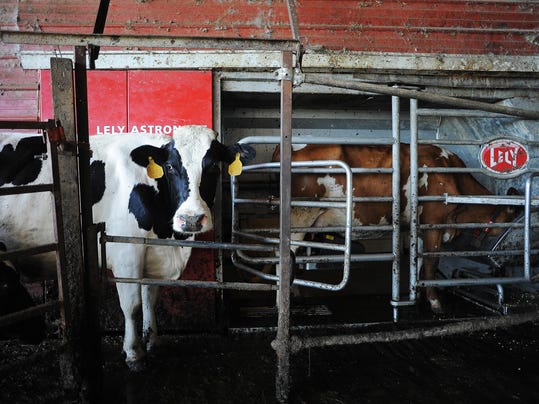 Robotic milking has helped free up time for other duties around and off the farm for a South Dakota dairyman.
Robotic milking has helped free up time for other duties around and off the farm for a South Dakota dairyman.
In the old days, Stuart Plucker never had a whole lot of time in the evenings to spend with his young children.
A dairy farmer doesn’t get that luxury. He’s a slave to the milking — four hours in the morning, another three to four hours at night, every single day.
And so it was for Plucker until he purchased his robotic milking system five years ago this October. Or in the language of the automation revolution, back in the old days.
“It’s made my life simpler,” the 34-year-old farmer said from his farm home five miles west of Tea. “It’s freed up my nights, that’s for sure. I have a young family, and I get to see them now.”
In a world where robotics and artificial intelligence are predicted to dramatically impact workforce needs in the future, agriculture has already been down that road.
At the dawn of the 1800s, almost 90 percent of Americans worked the land in one way or another. Today the country’s farm population is between 1 and 2 percent. That trend remains clear in South Dakota. Since 1980, the state’s rural population has grown by 2,500 residents, according to Census figures, while the urban population is up 160,000 in that same period.
Former state Agriculture Secretary Walt Bones says his father once employed 45 people full and part time on their operation northeast of Parker. “Now we’re farming more acres and have more cattle, and we’re doing it with eight people,” Bones told the Argus Leader. “It’s bigger tractors. It’s auto-steering and GPS mapping. We have all these sensors now on the combines and tractors.”
It was industrialization that moved farming from the horse and plow to gasoline-powered tractors and combines, enabling sodbusters to turn more soil with less effort. Eventually it enabled operations to get bigger. As they did, small farms disappeared, and the number of people working the land declined.
The technology revolution that has made Plucker’s life simpler means less labor to help milk his cows as well. In the larger scheme, it means production agriculture has been able to move out of chemistry into biology — relying less on herbicides and pesticides to protect plants because genetic engineering has built that resistance right into the makeup of the seeds.
Producing, of course, less work for the crop sprayers.
Fewer jobs in the countryside sent farm laborers into South Dakota manufacturing plants. At the same time, farm families were having fewer children. That’s less hands to help with the farm chores. And if they don’t stay on the land once they reach adulthood, that ultimately translates into a smaller workforce for the manufacturing sector, too.
“There has been a constant migration to the city,” Bones said. “People can earn more while working less hours. And here’s how it plays out for farmers. As long as all the kids are home and helping milk cows, you’re in great shape. Once they go off to college or get other jobs, then you sell your cows.”
That said, Lucas Lentsch, South Dakota’s current agriculture secretary, reminds us that seed still needs to be put in the ground. Crops still need to be harvested. Someone still has to unplug machinery when it gets clogged.
That requires some farm labor, Lentsch said. But beyond that, he believes much of that labor lost on the farms has simply shifted to value-added agriculture industries in town or in urban centers. Again, maybe they’re helping to manufacture or fabricate farm buildings, he said. Perhaps they have gone off to college to develop computer science and agronomy backgrounds.
“I think agriculture labor has many different forms,” he said. “Intellectual labor continues to evolve with, say, marketing techniques. You need intellectual labor to test equipment. And as you see what has evolved in genetics, as you see what has evolved in best practices and equipment availability, there’s been a realignment of positions. It’s turned direct labor on the farm into manager roles.”
That said, there will always be a need for manual labor in agriculture, he said, whether it’s building fence or opening gates or keeping track of how the animals are faring under the influence of technology.
Perhaps that’s true, said Martin Ford, a Silicon Valley software developer whose book, “Rise Of The Robots,” is a treatise on technology and how its evolution threatens to create what he calls “a jobless future.” He still believes the ongoing evolution of automation and artificial intelligence will impact South Dakota agriculture even more than it has.
“I’m sure you have cattle or hogs that require manpower in your slaughter houses,” Ford said. “But you’ll see robots slaughtering animals in the future. That will certainly happen. And again, that will definitely impact agriculture jobs there.”
Whether that impact continues to be a net declining of farm-related jobs, or simply a shifting of labor needs, remains to be seen.
All Stuart Plucker knows is that his robotic milking system means he now has more time to work in the field of cattle breeding. It also means he has more time for his family.
“I’ve got a lot more freedom,” he said. At least more than he did in the old days.
Five years ago.
Source: Argus Leader









